|
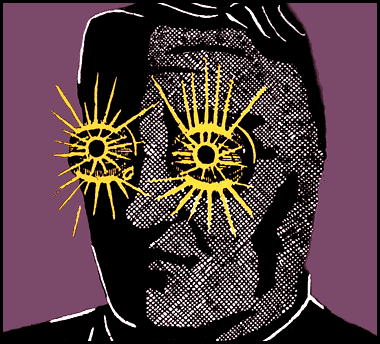

They come to hear Edward R. Tufte, the top dog in a field known as "information design," in the way the ancient Greeks must have gone to hear Socrates...
By Alan Bisbort
They come to hear Edward R. Tufte in the way the ancient Greeks must have gone to hear Socrates, or would-be transcendentalists cut a path to 19th century Concord. At least that is how they came to the Hartford Hilton on September 20 and 21 and the Stamford Marriott on Sept. 28, 29 and 30. They came because these were the first times Tufte, who lives in Cheshire, has offered his legendary "Presenting Data and Information" seminar in his home state. And, oh yes, they could not consider themselves truly on the tip of their professions if they hadn't at least heard of "E.T."(his preferred nickname).
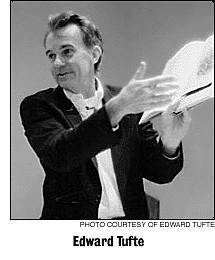
They came in workboots and jeans, wingtips and power suits, sneakers, heels and sensible hushpuppies. Some lugged CEO-wannabe briefcases choked with investment tipsheets and glossy annual reports. Others slung backpacks over shoulders, filled with yogurt, fruit and bottled water. They had perfect hair and they had orange hair sculpted like gilded torches and some had no hair at all. They were clean shaven and they had unkempt ZZTop beards.
They came from the cubicles of insurance and health care companies, banks, weapons plants, private utilities, public libraries and the government. They came from the labs of biotech firms and med schools, the classrooms of Miss Porter's School and the Fieldston School in the Bronx. They came from nonprofits like Easter Seals and The Nature Conservancy. They came from the Connecticut State Lottery, for crying out loud.
They came because Tufte is the "da Vinci of data" and his one-day course has, among a certain segment of our civilization, taken on the aspects of a rite of passage. The power brokers, the visionaries and in-house creative geniuses know Tufte. The Dilberts and the honchos know Tufte. Ralph Nader knows Tufte. Bill Gates knows Tufte. Hell, you know Tufte, even if you've never heard of him. His mark is on every clearly designed Web site, on the pages of every quality magazine and newspaper in the country, on assembling instructions, train schedules, menus, brochures, itemized hospital bills, you name it, Tufte has been there ahead of us.
Tufte is the top dog in a field known as "information design," which he has cultivated for over three decades in classrooms at Princeton and Yale, teaching statistical evidence and political science. His talent is that he is the unrivaled master at making sense of data, or "evidence," and presenting it in ways that make sense to others. With the proliferation of information outlets, due to the explosion of everything from desktop publishing and cable broadcasting to the Internet, the field has become more like a black hole of misinformation, disinformation, half-truths, raw unsifted data and just sheer overwhelming numbers.
And Tufte estimates that worldwide well over two trillion statistical graphics are published on paper, TV screens, or over the Internet each year. The potential for this data to become a snowballing mound of what he calls "chartjunk" is not just strong but probably inevitable.
Up steps Tufte to cut through this chaos. Many of the innovations and much of the clarity that has driven this field are the result of Tufte's work, embodied in his three books, The Visual Display of Quantitative Information (1983), Envisioning Information (1990) and Visual Explanations (1997).
During his years as a professor, Tufte not only accumulated a vast quantity of information about "information design," but he discovered he had a gift for getting that message across. Until earlier this year, Tufte supplemented his full-time job as a political science professor by putting together two or three "tours" a year of his successful seminar. With the help of a tireless staff of four -- who sport "E.T. Tour" shirts in a sort of mockery of rock and roll bands -- Tufte books a hall, sends out 100,000 flyers, signs up attendees by phone or e-mail, arranges for all sound systems, props and visuals (including his three books, which come with the fee) and simply compresses his life's knowledge into a 7-hour "show."
But after 32 years as full professor -- and numerous stodgy scholarly tomes, the less said about the better -- he retired from college teaching this summer at the age of 57.
"It's easier for me to write and teach on my own. There was no place for me or my work at Yale," explains Tufte, alternately miffed and relieved by this turn of events. "Teaching on the road eliminates the age segregation. It's not just very smart 20-year-olds."
Indeed, he has turned to his roadwork with a joyful vengeance. Until this year, he'd concentrated his courses in the Washington, D.C. and San Francisco areas, but now has booked regular swings through Boston, Dallas and Austin.
Judging from the turnout in Hartford and Stamford -- averaging over 300 attendees at each class -- his home state will be a regular venue too. In addition, his three books are in the process of being translated into six other languages, including Japanese and Chinese, so an international "E.T. Tour" is not out of the question. And after that...well, a lunar tour would be perfectly in character.
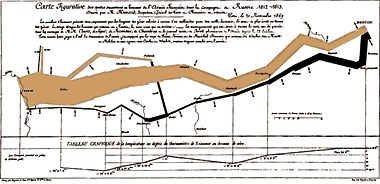
The Best Design Ever: Edward Tufte says that this map, by Charles Joseph Minard, may be the most effective graphic illustration ever made. The map portrays the losses of Napoleon's army during his 1812 invasion of Russia. Beginning on the left, with an army of 442,000 men, the graphic shows the march to Moscow. The black line moving from right to left, shows Napoleon's retreat. "Minard's graphic tells us a rich, coherent story," says Tufte.
Perhaps the most compelling way to demon-strate the importance of Tufte's thoughts is in the context of life and death decisions. Every day, in a hospital, he explains, as the life of a patient hangs in the balance, many of the decisions that are made about that patient are determined by how medical data is compiled, stored and accessed. In his seminar Tufte spends a portion of the talk interpreting an itemized bill of a fatally-ill patient, explaining when and how the attending physicians made their decisions, based entirely on the set of numbers, charts, and graphs available to them. He also talks about how most medical records are meaningless in the ongoing treatment, that they are "write-only" forms, scribbled notes kept only for legal purposes in case something goes horribly wrong.
He demonstrates both the old and failed methods and the stunningly effective, accurate and useful computerized method for data gathering at hospital bedsides he, with the help of Yale medical professor Seth Powsner, designed and patented.
Even more compelling proof for the need to take visual design more seriously is Tufte's lengthy deconstruction of the January 1986 launch of the Space Shuttle Challenger. The launch should have never been allowed to go as planned, he argues, and all of the scientists and technicians knew this the day before the planned event. Showing the necessity for quick, artfully rendered and persuasive graphics, Tufte talks about how the technicians who were concerned about the resilience of the O-rings had only 11 hours before the launch to convince the NASA politicos to abort the mission. They failed mostly because of lousy information design, Tufte argues.
His conclusion, in fact, after 15 pages of concise, clearly argued text and charts: If the history of O-ring damage in cold-temperature flights had been disseminated in some clear data graphic -- rather than buried in thousands of pages of engineering transactions and scribbled hastily assembled "chartjunk" of a "haplessly dequantified style" -- the launch would have been canceled, the tragedy averted. But, as Tufte bluntly puts it, "The charts were unconvincing; the arguments against the launch failed; the Challenger blew up."
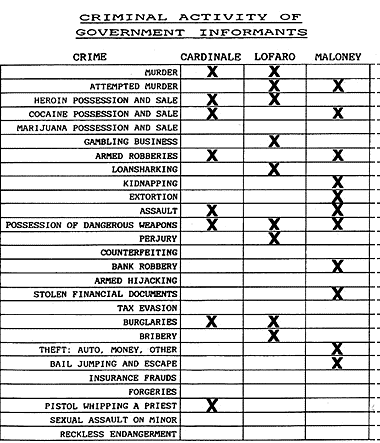
A Graphic You Can't Refuse: Mobster John Gotti's attorneys used this graphic (detail) in 1987 to show the jury the criminal history of the witnesses against their client. The chart helped illuminate a major weakness in the case against Gotti.
As they filed into what could be any impersonal conference hall, a wiry and graceful Tufte greets each person individually, turning this rented corporate space into his intimate stage. And as he inscribes his "E.T." on the title pages of his three books, he asks each person what they do, how they heard about the course, what they hope to learn. He listens closely and then gives them a brief reading assignment, saying, "That's your homework before I get started."
Then -- and this is the real Tufte touch -- he gives them a tweak of encouragement.
"You're in the right place today," he says. "Spend some time with the books. They repay study."
What has all the earmarks of a canned act -- like one of those godawful motivational speakers advertising proper handshake grips in the in-flight magazines -- is instantly dispelled upon opening any one of Tufte's books to any page. When he speaks about them, he holds them as reverently as if they were merely channeled through him by the spirits of Galileo, Leonardo and Isaac Newton, and any of the many other great guiding lights for truth and beauty.
Like William Playfair. Like Charles Joseph Minard, whose multidimensional map of Napoleon's failed Russian campaign of 1812 is, E.T. calls, "War and Peace as told by a visual Tolstoy." Further, "It may well be the best statistical graphic ever drawn."
Perhaps not surprisingly, E.T. is this passionate about things even when he's at home. Giving a tour of his seven-acre property in Cheshire, which he and landscape architect Tom Pritchard restored to natural beauty after a period of neglect, Tufte points out the way the leaves on the poplar shimmer in the wind or the willow perfectly accentuates the rippling water in the rain-swollen creek.
E.T. has fashioned this paradise for himself, his wife, Inge Druckrey (a professor of graphic design), and his three golden Labradors. On the grounds, has installed a monument to his lifelong obsession. It is his 12-foot tall, 5-ton stainless steel sculpture entitled "Escaping Flatland."
Tufte's elegant sculpture sits at the bottom of the hill behind his house, on the flattest space in his domain. "Escaping Flatland" follows a visitor around the entire rim of the seven acres, changing shape as you change perspective. From a distant hill, it looks like an otherworldly vessel. From up close, it nearly disappears into the natural habitat, picking up every nuance of green, brown, blue and white that drifts by. Tufte seems to see something new in it every time he stands beside its multiple pillars.
Escaping flatland is, indeed, his life's calling. That is, Tufte aims for nothing less than pushing the communicative abilities of the endless two-dimensional flatlands that we encounter thousands of times a day in the form of pieces of paper, computer monitors and video screens. "All the worlds (physical, biological, imaginary, human) that we seek to understand are inevitably and happily multivariate in nature," he writes. "Not flatlands."
One way to escape flatland, the clunkiest way, is to build a model. Tufte pulls out his copy of Euclid's Geometry (1570) -- careful to note that his copy was previously owned by Shakespeare's contemporaneous playwright, Ben Jonson. In this book, Euclid demonstrates solid geometry with a "pop-up," three flaps of triangular paper that come together in a 3-D point. In tribute, Tufte reprints an identical pop-up over 400 years later in Envisioning Information.
The other way -- the only other way -- to escape flatland is "by being real thoughtful in our visual displays." The pop-up takes Tufte 30 seconds to demonstrate at the start of his course. The other method consumes the better part of the next seven hours.
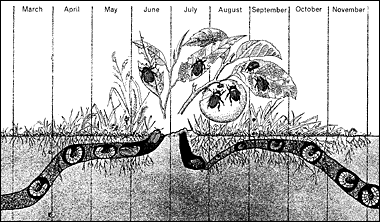
Nasty, Brutish and Short: The life cycle of the Japanese beetle (detail), a great graphic, and "a smooth escape from flatland," says Tufte.
It's time well spent, according to the seminar's diverse attendees. John Matthiessen, communications manager for the Connecticut chapter of The Nature Conservancy in Middletown, went with three other staffers to hear Tufte. Since it entailed a "pretty significant expense," the course was something they'd been thinking about for some time. They were not disappointed; in fact, Matthiessen said, "We are excited and will each apply what we learned in different ways.
"Focus on your content, is his most powerful message, I think," he added. "Technical innovations may or may not be useful but it doesn't matter if you have nothing to say. This seem especially important now with the proliferation of Web sites. What he teaches sounds revolutionary but maybe it shouldn't be. It's a sad comment when clear thinking is considered revolutionary. How did all that get lost in the first place?"
Particularly inspiring to Matthiessen was to hear Tufte "nix the whole KISS principle, the keep it simple thing. People are as smart as you are so why not treat them that way? Tufte really skips over the b.s."
Jeffrey Osborne, a coordinator of international activities for the American Chemical Society in Washington, D.C., was especially interested in Tufte's comments on the limitations of the Internet.
"Between the infinite resources of the Web and the infinite power of the human brain and its memory, there is the chokepoint of presentation of extremely poor resolution. No one wants to read a lengthy text from a screen. Whenever one can, one prints it. Which affects the quality of the Web and degrades it -- so many pictures, movies, sounds and gimmicks, which does nothing to improve our general attention span. As a 'learning tool', to use the jargon, the Internet is overrated for that reason."
James O'Shaughnessy works as an information technologist for the Boston-based Teradyne company. "I came in focusing on how I could become better at both presenting graphics and critiquing other people's graphics. We spend a great deal of time at Teradyne attempting to clearly present a lot of data using effective graphics."
For him, the most enduring outcome from Tufte's class: "I put all graphics, including my own, under a finer critical microscope. If my critical microscope was 10x when I entered the course, it was 100X when I left. He reminded me of Dr. Emmett Brown from the Back to the Future movies, not only in his appearance but also in his passion for the subject matter."
Indeed, throughout the day's performance, Tufte speaks in bursts of wisdom that though seemingly well-worn have the unusual benefit of being trustworthy and infused with deep scholarship:
- "Get your viewers out of the puzzle-solving business."
- "Good design cannot rescue bad content."
- "Good design is clear thinking made visible. Bad design is stupidity made visible."
- "We must study disinformation and trickery and then reverse those techniques for the good of truth telling."
- "Only two industries refer to their customers as 'users': computer design and drug dealing."
- "It's better to have information adjacent in space than stacked in time."
While being unavoidably hurled into cyberspace himself -- Tufte counts IBM, Lotus and Hewlett-Packard among his many corporate clients -- he still believes that a single sheet of paper has more resonance, staying power, and potential for the ripple effect in a thinking person's mind.
When E.T.'s guests leave at the end of the seminar, they, too, look ready to change the world. Or at least make it a clearer, more intelligent, more truthful and rational place. Tufte's joy in putting across what to him is his life's mission is palpable and so infectious that you can be forgiven for thinking, upon leaving the Hartford Hilton or the Stamford Marriott, that you, too, can do it. You can clarify your content, move mountains of entrenched institutional dysfunction and calcified intellect. You can escape flatland.
It's even conceivable that you could leave his seminar, armed with his books and the visual tools he has given you, and you might even be able to duplicate what he does, if, if, if. . .if you had his charisma, wit, intelligence, stamina, confidence, grasp of material, chutzpah, etc. etc.
But then it hits you on the drive home with the force of a Challenger explosion. You are stuck in the pointless gridlock of traffic, driving past mindless sprawl and soul-deadening highrises, scooting past dreaded neighbors and kerplunked back in your favorite seat at home. The epiphany: Edward Tufte is one of a kind and this is, perhaps, his greatest achievement. He's Edward R. Tufte and you are not.
Related stories:
Copyright ©1999 New Mass. Media, Inc. All rights reserved.
|